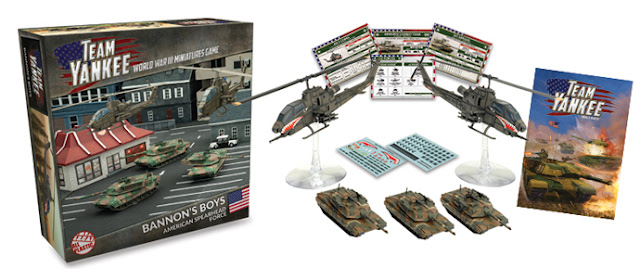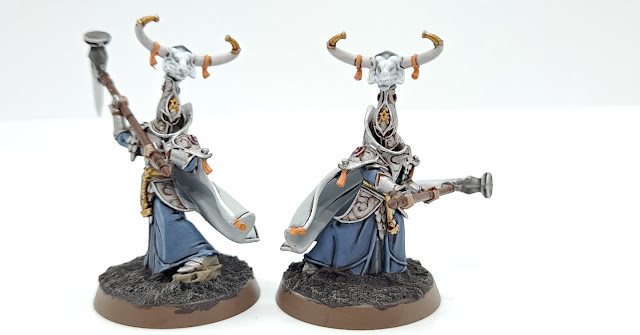On August 4th 1985 the unthinkable happened; the Soviet Union crossed the Iron Curtain and invaded West Germany.
Soviet Tanks rumbled though West Germany, making significant gains in territory in the north and south of the country.
NATO had long suspected a Soviet strike and, whilst the their forces were not fully prepared to meet the Soviet advance, their defences held in key locations throughout Germany.
The Soviets had struck hard and fast; now it was NATO's turn to counter-strike. War had been declared, and the Iron Curtain would fall once and for all...
Now clearly this is not the History we know. It forms part of the opening narrative for World War III: Team Yankee; a 15mm combined-arms war-game made by Battlefront Games.
My fellow warlord, Neil, is a big fan of Battlefront games and has been pitching Team Yankee for a little while now (as regular readers will know from his WW3 series). Earlier this year (pre-lockdown!) I had brief demo of the game and really enjoyed it; it was a deep and detailed games system that played in a fun and fluid manner.
Off the back of this I was gifted a starter set, and I've used lockdown as a bit of an excuse to crack it out and take my first steps into a darker alternate history; one where the Cold War got very hot!
My History with Historics
Anyone that knows me will tell you I don't really do Historics. Part of this is because I prefer the aesthetics of high fantasy and science fiction; the worlds you can build when you're not restrained by actual physics or politics are pretty amazing.
Equally, I don't really like playing Historics because of the limitations it places on narrative. If we take something like WW2, the Vietnam War, the Gulf War, the Korean War (pretty much any major conflict over the last hundred years actually) we've got a pretty good idea of all the major battles, where and when they took place, and who won. As a result I find it difficult to fully engage in the setting because I can't create my own narrative.
Weirdly, I don't like the idea of playing The Lord of the Rings miniatures game for the same reason. JRR Tolkien did a pretty good job with that narrative, so fighting battles within that setting that didn't feature in the book feels a tad sacrilegious!
Now... I will acknowledge a certain level of hypocrisy here, because whilst I've admitted I like to create my own narrative I have also played the Knight Models Batman Miniatures Games and their (now discontinued) Marvel Miniatures Games, and I've been temped by the Fantasy Flight Games Star Wars: Legion; systems which have well defined narratives just like Historics
That leads me on to my third reason for never engaging with Historics - I'm actually not that into Military History.
I know a fair few people who find tanks, guns, armour and weapons of many (or all) era's fascinating. Frankly, it just doesn't do that much for me.
So whilst I appreciate there are many, many reasons to engage in Historics (reenactment, what-if stories, appreciation of the people/ history, appreciation of the technology... I'm sure the list goes on) it's just not something that's hooked me before.
Why Team Yankee?
Now you're probably asking yourself - what makes Team Yankee different?
Well - there's a couple of things:
Firstly - it's not quite historic
Team Yankee is set in an alternative past; a version of 1985 that saw the Soviet forces attack the west, rather than usher in the reforms that would ultimately undo the USSR.
This gives a certain level of narrative freedom (more so than normal Historics) to explore new things and tell new stories
Second - it's a new perspective
As a relative Noob, I found my intro to Team Yankee refreshingly different to the other games I've played. Up to this point the only combined arms game I've played is Dropzone Commander, and whilst that game is pretty solid it's based pretty heavily around aircraft (kind of in the name really!)
Team Yankee is very much "tank level"; the focus is your armored assets, with strike fighters, helicopters and infantry playing supporting roles.
Third - it's a fresh game system
Unsurprisingly the rules are written with the Tank as your "default" model, and orientates around that. This means a lot of the rules are written with that in mind.
Take movement, for example.
Your typical 1980's tank doesn't have all the high tech, AI-supported weaponry of the far future; you've got manual gunners and manual aiming. If you're flooring it across the German countryside you're unlikely to be able to load and fire your main armament, and this is reflected in the rules with two distinct movement speeds; "move and shoot speed" and "fast movement speed"
Fourth - the models are pretty cool
Say what you want... tiny tanks are pretty cool. If you're interested in your military history, then there's plenty of tanks and APCs available that recreate the arsenals of both the NATO and Warsaw pact forces had available in the mid 1980s. Second edition pushes the narrative into the 90's which means, from what I can gather from the articles I've read, more 90's military hardware will be introduced into the "Cold War gone hot" setting, which should be cool
Where to start with Team Yankee
Team Yankee boasts an impressive number of starter sets. With two major sides in the conflict (NATO and Warsaw Pact) you've got a surprising amount of choice with where to begin.
The NATO forces offer a pretty diverse set of models; French, British, United States, West German and Australian forces all have unique models, alongside a pool of shared NATO models to play the smaller NATO nations (Canada, Australia, New Zealand, the Netherlands)
The Warsaw Pact forces share models a lot more than NATO, which is a double edged sword. Whilst the models look unique, the rules are subtly different between the differences Warsaw Pact forces (East Germany, Polands, Czechoslovakia and the USSR) which means you can buy one set and test it a few ways before settling on a force
I should also note that, as a Noob, I'm just focusing on the European conflict here. There's an expansion to the game which takes the conflict into the Middle East, adding Iraqi, Iranian and Israeli forces into the game. At the moment I know very little about this side of the game!!!
As I said at the start of the post, I was gifted some Team Yankee to get me started; doubly started actually, since I was gifted two Starter Sets
The first, Bannon's Boys, features three M1 Abrams battle tanks and two AH-1 Cobra attack helicopters
The second, Ryans Lethernecks, features three M60 battle tanks and six HMMVVs, which have a few different build options
As you can likely tell from the box art, both these starter sets are for the US forces.
As a big fan of the Call of Duty games, the US military is the one I'm most familiar with (at least visually) and so seemed like a good place to start.
Well... I'd have gone British but Neil's doing them and I can't play the same army as someone else, regardless of game system!!
I'd be doing you all a disservice if I didn't say at this point that these boxes have now been discontinued! The second edition US-update is coming out July 4th, and as part of that release a new shiny starter box is coming... and it's a doozy!
More on that another day though!
Getting stuck in!
With no real knowledge of US military history, I turned to google and found this article talking about military camouflage; specifically the NATO tri colour scheme introduced in the mid-80s.
Whilst all of the American armor shown in the official Team Yankee box art is painted in the US MERDC scheme I though the tri colour scheme would look more modern, and help with the more fictional force I wanted to portray
I knocked together Bannon's boys pretty quick and set about painting them.
First up - the M1 Abrams
As you can see, I've gone for a stylised NATO camo pattern. As I think I've made pretty clear thoughout this post, historical accuracy is taking a back seat for me. Instead I'm working towards having a quickly painted, distinct, semi-realistic/ stylised force that's ready to play some tester games pretty quickly.
(Part of this is practical of course! I don't want to heavily invest in new paints for a game system I'm not playing. I've used Citadel colours to achieve the effect above)
The models were pretty quick to paint, taking only 5 steps:
- Undercoating all models Dark Angels Green
- Painting black stripes/ blotches in Abaddon Black
- Painting brown stripes/ blotches in Doombull Brown
- Picking out the metallic elements (wheel arches, pintle-guns and the antennae) with Skavenblight Dinge
- Drybrush the whole model with Baneblade Brown, focussing more heavily on the tracks
The whole thing takes less than an hour to give a decent, battle ready paint scheme.
For the Tank commander popping his head out of the tank I did exactly the same as above, applying the same colours to his jacket and helmet, with two extra steps:
- Paint flesh Cadian Fleshtone
- Wash with Reikland Fleshshade
Up next, the AH-1 Cobra's.
I took a little bit of time thinking about the Cobra. Did I want to paint them in Army colours (camo) or more of an Airforce style grey. I looked at some photos online and (without knowing too much about the military organisation and disposition of forces) decided to go Grey. It felt like a safe bet, considering the box artwork had the Helos in grey too
As with the Abrams I approached these model with a drybrush heavy, "speed painting" style - I think they took 1-2 hours total to complete
- Undercoat the model Eshin Grey
- Paint the weapons pods, exhaust ports, rotor mechanism and landing skids Skavenblight Dinge
- I then washed the whole thing with Nuln Oil
- I drybrushed the chassis Mechanicus Standard grey
- The rotor blade tips were painted Averland Sunset
- Windscreens were based Caledor Sky
- Windscreens were glazed with successive layers of Russ Grey to build up a mottles, semi-translucent effect
Step 7 was definitely the weakest part of this paint job, and something I'd look to revise if I get heavily into the same. The windscreens looks distinctly average (and that's being generous) but for now they'll make do - sufficient for getting intro games in.
Battle Ready
With the Bannon's Boys done I'm battle ready! It's a far cry from tournament/ full game standard, but for a few intro games I'm ready as soon as lockdown is relaxed enough. In the mean time I'm working on Ryan's Leathernecks to augment the force even more.
Neil has found a really nice looking starter campaign to play which introduces house rules for playing smaller games (relaxing force organisations, limiting points and unit options, etc) which should be perfect for getting started.
So watch out for some updates when Lockdown ends about that!
If you're interesting in hearing more about Team Yankee, particularly from an ABSOLUTE BEGINNERS perspective then sound off in the comments below and I can look at fleshing out this blog series with book reviews/ rules comparisons and breakdowns, some historic perspectives (make me work for the hits!) or any additional content.
'till next time all - stay safe and happy hobby!










No comments:
Post a Comment